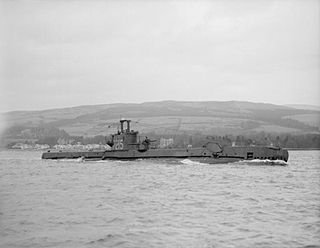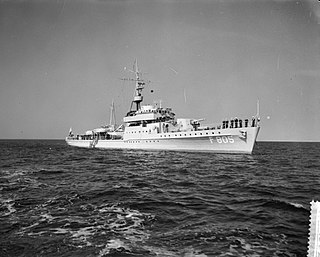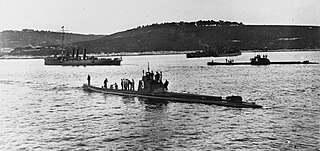
HMS Sceptre (P215) was a third-batch S-class submarine built for the Royal Navy during World War II. Completed in April 1943, she spent the majority of her career in the North Sea, off Norway. After an uneventful patrol, the submarine participated in Operation Source, an attack on German battleships in Norway using small midget submarines to penetrate their anchorages and place explosive charges. However, the midget submarine that she was assigned to tow experienced technical difficulties and the mission was aborted. During her next four patrols, Sceptre attacked several ships, but only succeeded in severely damaging one. She was then ordered to tow the submarine X24, which was to attack a floating dry dock in Bergen. The operation, codenamed Guidance, encountered difficulties with the attacking submarine's charts, and the explosives were laid on a merchant ship close to the dock instead. The dock was damaged and the ship sunk, and X24 was towed back to England. Sceptre then conducted a patrol in the Bay of Biscay, sinking two German merchant ships, before being reassigned to tow X24 to Bergen again. The operation was a success, and the dry dock was sunk.

Admiral Hipper, the first of five ships of her class, was the lead ship of the Admiral Hipper class of heavy cruisers which served with Nazi Germany's Kriegsmarine during World War II. The ship was laid down at the Blohm & Voss shipyard in Hamburg in July 1935 and launched February 1937; Admiral Hipper entered service shortly before the outbreak of war, in April 1939. The ship was named after Admiral Franz von Hipper, commander of the German battlecruiser squadron during the Battle of Jutland in 1916 and later commander-in-chief of the German High Seas Fleet. She was armed with a main battery of eight 20.3 cm (8.0 in) guns and, although nominally under the 10,000-long-ton (10,000 t) limit set by the Anglo-German Naval Agreement, actually displaced over 16,000 long tons (16,000 t).

The Admiral Hipper class was a group of five heavy cruisers built by Nazi Germany's Kriegsmarine beginning in the mid-1930s. The class comprised Admiral Hipper, the lead ship, Blücher, Prinz Eugen, Seydlitz, and Lützow. Only the first three ships of the class saw action with the German Navy during World War II. Work on Seydlitz stopped when she was approximately 95 percent complete; it was decided to convert her into an aircraft carrier, but this was not completed either. Lützow was sold incomplete to the Soviet Union in 1940.
At the outbreak of the Second World War Nazi Germany's Kriegsmarine had 21 destroyers in service, while another one was just being completed. These 22 vessels – comprising 3 classes – had all been built in the 1930s, making them modern vessels. Including that final pre-war vessel, a further 19 were brought into service during the war and more were captured from opposing navies, including the Italian Navy after the Italian Armistice with the Allies in 1943.
The Austro-Hungarian U-boat fleet was created in the decade prior to the First World War. They were built to a variety of designs, many under licence from Germany. They served throughout the war against Italian, French and British shipping in the Mediterranean Sea with some success, losing eight of the twenty eight boats in service in return. They were reinforced by the Imperial German Navy’s Pola Flotilla, mainly comprising coastal U-boats transported by rail from Germany's northern shipyards to the Austrian ports on the Adriatic Sea. Following the end of the war in 1918, all Austrian submarines were surrendered to the Entente powers, who disposed of them individually. As both Austria and Hungary became landlocked in the aftermath of the war, no Austrian or Hungarian submarines have been commissioned since.

HNLMS Van Speijk was a K-class sloop, designed in the late 1930s to replace the aging Brinio-class gunboats of the Royal Netherlands Navy. Incomplete at the start of the German invasion of the Netherlands and not yet launched, K3 was found undamaged by the German forces. The Kriegsmarine ordered her completion, then commissioned her for service in Norwegian and German home waters.

Vasilefs Georgios was the lead ship of her class of two destroyers built for the Royal Hellenic Navy before the Second World War. Flagship of the navy's Destroyer Flotilla, she participated in the Greco-Italian War in 1940–1941, escorting convoys and unsuccessfully attacking Italian shipping in the Adriatic Sea. While under repair during the Axis invasion of Greece in 1941, Vasilefs Georgios sank when the floating drydock that she was in was either scuttled or sunk by German aircraft.
The German torpedo boats of World War II were armed principally, if not exclusively, with torpedoes and varied widely in size. They were not small schnellboote but small seagoing vessels, the larger of which were comparable to destroyers. During World War II, German torpedo boats were administratively grouped into several torpedo-boat flotillas.

The U-10 class was a class of five submarines or U-boats of the Austro-Hungarian Navy during World War I. The class was similar to the German Type UB I submarine of the German Imperial Navy ; the first two boats delivered to Austria-Hungary had previously been commissioned in the German Navy.

The U-3 class was a class of two submarines or U-boats built for and operated by the Austro-Hungarian Navy. The U-3-class boats were designed and built by Germaniawerft of Kiel, Germany. The class was a part of the Austro-Hungarian Navy's efforts to competitively evaluate three foreign submarine designs.

The U-27 class was a class of eight submarines or U-boats built for and operated by the Austro-Hungarian Navy during World War I. The class was based upon the German Type UB II design of the German Imperial Navy and was constructed under license in Austria-Hungary.

Z33 was a Type 1936A (Mob) destroyer built for the Kriegsmarine during World War II. Completed in 1943, the ship was damaged during the raid on the island of Spitsbergen in September and spent all of 1944 in Norwegian waters. She was damaged by British aircraft attacking the battleship Tirpitz in July. Z33 escorted troop convoys from northern Norway when the Germans began evacuating the area beginning in October. She ran aground in early 1945 as she was sailing for the Baltic and was badly damaged. While the ship was being towed to port for repairs, she and her escorts were attacked by Allied fighter-bombers. Z33 finally reached the Baltic in early April, but was reduced to reserve for lack of fuel. The ship was transferred to Cuxhaven and decommissioned shortly before the end of the war.

Z30 was one of fifteen Type 1936A destroyers built for the Kriegsmarine during World War II. Completed in 1941, the ship was transferred to Norwegian waters in early 1942 where she remained for most of the rest of her career, escorting convoys and laying minefields. She played a minor role in the indecisive Battle of the Barents Sea at the end of the year and was damaged during the raid on the island of Spitsbergen in September 1943.

Lützow was a heavy cruiser of Nazi Germany's Kriegsmarine, the fifth and final member of the Admiral Hipper class, but was never completed. The ship was laid down in August 1937 and launched in July 1939, after which the Soviet Union requested to purchase the ship. The Kriegsmarine agreed to the sale in February 1940, and the transfer was completed on 15 April. The vessel was still incomplete when sold to the Soviet Union, with only half of her main battery of eight 20.3 cm (8.0 in) guns installed and much of the superstructure missing.

The O 21 class was a class of seven submarines, built for the Royal Netherlands Navy. The boats were still incomplete at the start of the German invasion of the Netherlands O 21, O 22, O 23 and O 24 were hastily launched and escaped to the United Kingdom. O 25, O 26 and O 27 were not able to escape and were captured by the German forces. The Kriegsmarine ordered the completion of the boats and they entered German service as UD-3, UD-4 and UD-5. The submarines diving depth was 100 meters (330 ft).

O 23, laid down as K XXIII, was an O 21-class submarine of the Royal Netherlands Navy that saw service during World War II. During the war she sank and damaged several ships.
UD-3 was an O 21-class submarine. The boat was laid down as the Dutch submarine K XXV and renamed O 25 but was captured during the German invasion of the Netherlands in World War II and commissioned in the Kriegsmarine.
K XII was a K XI class patrol submarines of the Royal Netherlands Navy. The ship was built by Fijenoord shipyard in Rotterdam.

ZH1 was the lead ship of her class of four destroyers built for the Royal Netherlands Navy in the late 1930s. Originally named Gerard Callenburgh, the ship was scuttled while still incomplete by the Dutch during the German invasion of the Netherlands in May 1940, but she was salvaged by the Germans a few months later and commissioned in the Kriegsmarine in 1942 as ZH1.

The Type 1940 torpedo boats were a group of 24 torpedo boats that were intended to be built for Nazi Germany's Kriegsmarine during World War II. Although classed as fleet torpedo boats by the Germans, they were comparable to contemporary large destroyers. They were designed around surplus Dutch propulsion machinery available after the Germans conquered the Netherlands in May 1940 and were to be built in Dutch shipyards. Hampered by uncooperative Dutch workers and material shortages, none of the ships were completed before the Allies invaded Normandy on June 1944. The Germans towed the three ships that were most complete to Germany to be finished, but one was sunk en route by Allied fighter-bombers and no further work was done of the pair that did arrive successfully. The remaining ships in the Netherlands were later broken up for scrap and the two that reached Germany were scuttled in 1946.














